Abstract
Portland cement has a limited shelf life because of the prehydration that can occur during storage. One approach to mitigating strength losses observed for concrete is to pretreat cement with a protective coating to slow the advance of prehydration. This study compared cement pretreatments with alkyl ketene dimer (AKD) wax and a combination of AKD + paraffin wax to a more traditional pretreatment approach using oleic acid. After exposing the treated cements to elevated temperature and humidity conditions, paste and mortar calorimetry tests showed improved resistance to prehydration reactions. The cements aged up to 12 weeks under the accelerated regime showed strength improvement for the mortars made with AKD and AKD + paraffin-treated cements relative to the mortars made with oleic acid-treated cement and mortars made with untreated cement. The wax can be added during clinker milling and additionally functions as a grinding aid.
1. Introduction
From its inception, the concrete industry has recognized the negative impacts on concrete made with Portland cement that has been stored under humid conditions or stored for extended periods of time. The task of determining a suitable shelf life for Portland cement was tackled over 100 years ago [1], with many subsequent studies, most focusing on strength loss [2,3,4,5,6,7,8,9] and changes in workability [10,11,12,13], whereas others focused on a better understanding of the fundamental mechanisms that drive cement prehydration and deterioration [14,15,16,17,18,19,20,21,22,23,24,25]. Several strategies have been developed to mitigate prehydration, including the addition of powdered limestone [23] and the pretreatment of cement with superplasticizers [26], polymer powders [27], or hydrophobic fatty acids [28,29,30,31,32,33]. In earlier studies, oleic acid showed some promise, but concrete made with cement treated in this way suffers from decreased strength, which is attributed to a resultant increase in entrained air content [34,35]. Others have focused on changes in the performance of admixtures when batching concrete with prehydrated cement [36,37,38], evolving into new strategies where superplasticizing or retarding admixtures are specifically used to help mitigate problems associated with prehydration [39,40,41,42]. Similar approaches using superplasticizers have been implemented with calcium aluminate and calcium sulfoaluminate cements [43] that also are highly susceptible to prehydration [44,45].
This article builds on our earlier efforts to extend the shelf life of cement using hydrophobic wax pretreatments [46,47]. The influence of cement storage at elevated humidity and temperature (~40 °C, RH ~100%) on the compressive strength of concrete and ultra-high-performance concrete was examined. While the wax treatments successfully impeded hydration and prevented strength loss, the study was limited to concrete mix designs containing calcined bauxite aggregate (Mohs hardness 9) used in armored vaults. To better explore the broader applicability of the approach, a more fundamental study based on mortars was initiated with some preliminary results reported, as well as an investigation of the feasibility of introducing wax during clinker milling [48]. This work was extended here to increase the duration of accelerated aging (at 37 °C, RH 95–100%) to 12 weeks, in an attempt to exhaust the protective capacity of the wax treatments fully and to include a more traditional fatty acid-based pretreatment (oleic acid) for comparison purposes. In addition to monitoring the fresh and hardened mortar properties, isothermal paste calorimetry was studied, as well as the evolution of cement microstructure during storage at an elevated temperature and humidity by using a scanning electron microscope (SEM).
2. Materials and Methods
2.1. Production of Treated Cements
Canadian Standards Association Type HE [49] cement from Ash Grove in Mississauga, Ontario, Canada, was treated with hydrophobic additives (Table 1) by milling in an attrition mill for 4 min. Cement density (Table 1) was measured once for each sample by a helium pycnometer (Quantachrome SPY-4, Boynton Beach, FL, USA). The particle size distributions were performed on single samples by laser diffraction (Horiba LA960, Kyoto, Japan), first without employing sonication and again with sonication, to provide an assessment of the extent of agglomeration. (Figure 1).

Table 1.
Cement density.
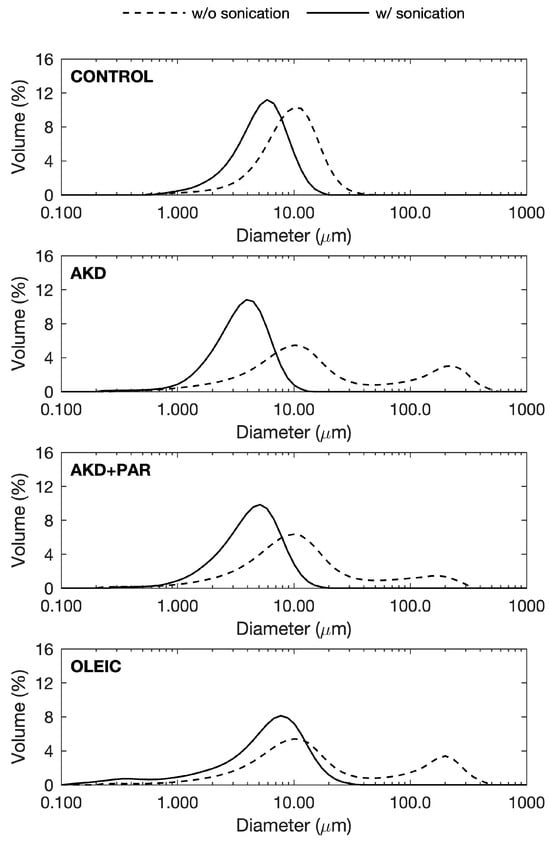
Figure 1.
Particle size distributions with and without sonication.
2.2. Accelerated Aging
The treated cements and control cement were first poured into pairs of plastic containers (34 × 21 × 10 cm) filled to depths of 4 to 5 cm, yielding ~2.5 kg of cement per container. These open containers were in turn placed inside large plastic boxes (37 × 54 × 15 cm), with the containers supported by thin plastic grid panels immersed in tap water. Temperature and humidity probes (Lascar EL-USB-2, Whiteparish, UK) were inserted in the space between the containers. The interior sides of the lids for the large plastic boxes were covered with filter paper (Whatman Grade 93, Marlborough, MA, USA) to absorb any condensation that might occur during storage in sealed conditions and prevent water from dripping directly onto the cement (Figure 2). The boxes were stored in a 37 ± 2 °C room. It took ~6 h for the boxes to achieve an equilibrium temperature and ~24 h to achieve an equilibrium relative humidity (RH) of 95–100% (Figure 3). The cements were sampled initially (without accelerated aging) and after 1, 2, 4, 8, and 12 weeks of accelerated aging.
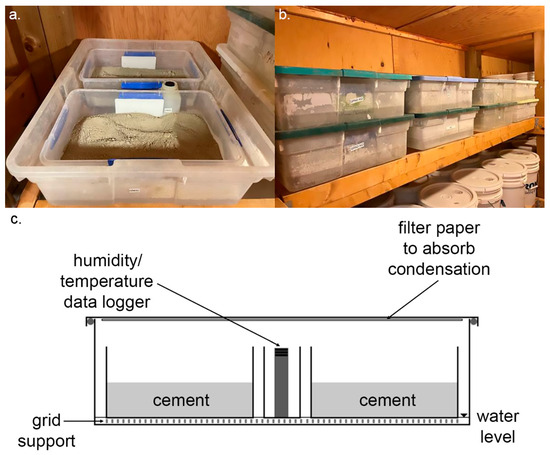
Figure 2.
Cements in containers within the humidity control box with the lid removed (a), sealed boxes in a heated room (b), and a diagram of the set-up (c).
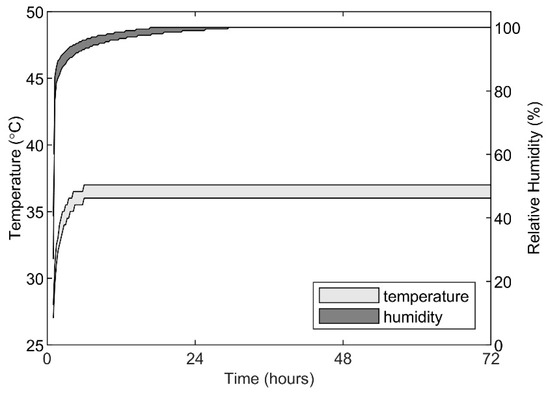
Figure 3.
Range of temperature and humidity during the transition from ambient to equilibrium.
2.3. Microstructural Characterization
The control cements and cements after exposure to accelerated aging were prepared individually as powder mounts by dispersing with compressed air over 12.7 mm (1/2 inch) dia. specimen stubs (PELCO pin mounts, Redding, CA, USA) covered with wet isopropanol carbon paint (PELCO Electrodag 502, Redding, CA, USA). No duplicate stubs were prepared. After drying, the stubs were carbon-coated and examined with a field emission SEM (Hitachi SU7000, Tokyo, Japan). Images were collected in a high vacuum at an accelerating voltage of 2 keV, a current of 94 μA, and a working distance that was varied between 7.1 and 11.5 mm using the lower chamber’s secondary electron detector. Laser diffraction particle size distribution measurements (Horiba LA960, Kyoto, Japan) were made on individual samples collected from the aged cements using sonication throughout.
2.4. Fresh and Hardened Mortar Testing
The cements were combined at a 1:2.75 mass ratio with ASTM C778 sand [50] along with a polycarboxylate superplasticizer powder (Kao Mighty 21PSD, Tokyo, Japan) at a dosage of 0.15 wt.% of the cement and City of Toronto tap water to achieve a water-to-cement ratio by mass (w/c) of 0.38. A superplasticizer was used to ensure adequate workability at this relatively low w/c value. For each ~1.5 L batch, the dry ingredients were added to a 2 L capacity bowl and inserted into the mixer (Hobart N50, Troy, OH, USA). Over the first 30 s of mixing (at ~140 rotations/minute), the water was added and then mixed for another 60 s. After this initial period, mixing was paused for 90 s, followed by another 60 s of mixing. A single mortar test for flow (ASTM C1437) [51] was performed on each batch, and duplicate air content tests (ASTM C185) [52] were conducted. For each batch, nine 50 mm cubes were cast, demolded 1 d after casting, and stored in a lime-saturated solution prior to compressive strength (ASTM C109) [53] measurements on three cubes at each curing duration of 7, 28, and 90 days.
2.5. Paste and Mortar Calorimetry
Isothermal calorimetry (Thermometric 3114 TAM Air) was conducted on single samples of cement paste produced with a w/c of 0.50 at a temperature of 23 °C for 7 days (no repetitions). Mortars were cast into 12 cm height 10 cm diameter plastic molds (Figure 4) and placed in a semi-adiabatic calorimeter (Concretec ConTest-8, Yavne, Israel) with temperature recorded for 3 days and compared to the surrounding room temperature datum. As with the pastes, mortar calorimetry was performed on single samples (without repetition).
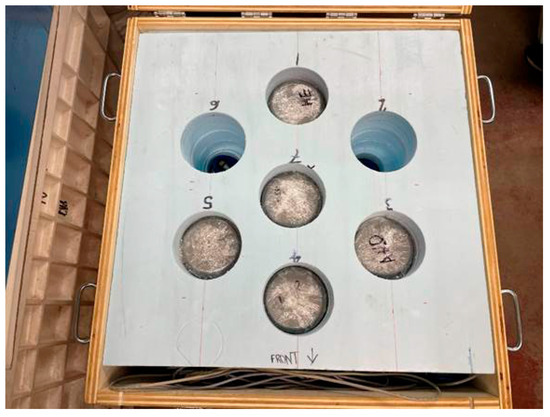
Figure 4.
Semi-adiabatic chamber with insulated lid removed.
2.6. Clinker Milling
A clinker sample was obtained from the Votorantim St Marys cement plant in Bowmanville, Ontario, Canada (Figure 5), and divided into 1 kg samples. The samples were milled in an 8 L laboratory ball mill, rotating at ~47 rotations/minute for a period of 1.5 h. The same additive dosages were used during milling (Table 1), but an additional run was conducted using just a commercial grinding aid (MAPEI BXR, Milan, Italy) at a dosage of 0.1 wt.%. After milling, the surface area was measured once for each sample by Blaine air permeability (ASTM C204) [54], and particle size distributions were performed on single samples by laser diffraction (Horiba LA960, Kyoto, Japan) in isopropanol with sonication.
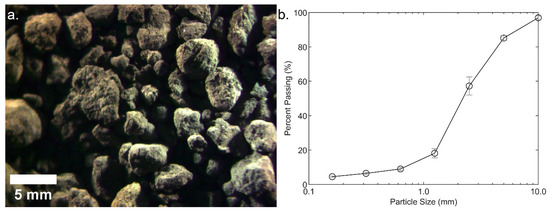
Figure 5.
Clinker (a) and gradation (b).
3. Results
3.1. Particle Size Distribution
The cements exhibited an increase in particle size as the aging duration increased (Figure 6). Overall, the control cement showed the greatest increase (Table 2).
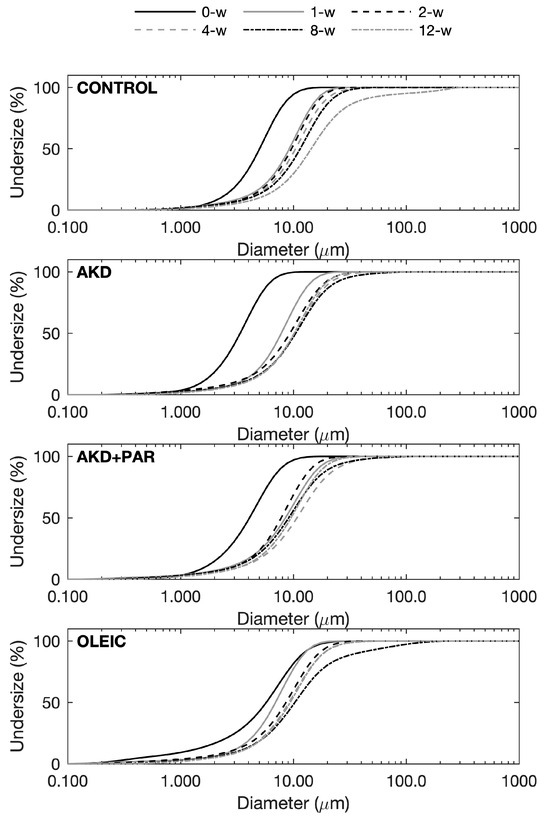
Figure 6.
Coarsening of the particle size over the accelerated aging regime.

Table 2.
The 10th, 50th, and 90th percentiles for the particle diameter after removal from accelerated aging conditions.
3.2. Scanning Electron Microscopy
All the cements showed signs of increased prehydration with time, as evidenced by the intensified development of hydration products with an increasing duration of accelerated aging (Figure 7, Figure 8, Figure 9 and Figure 10).
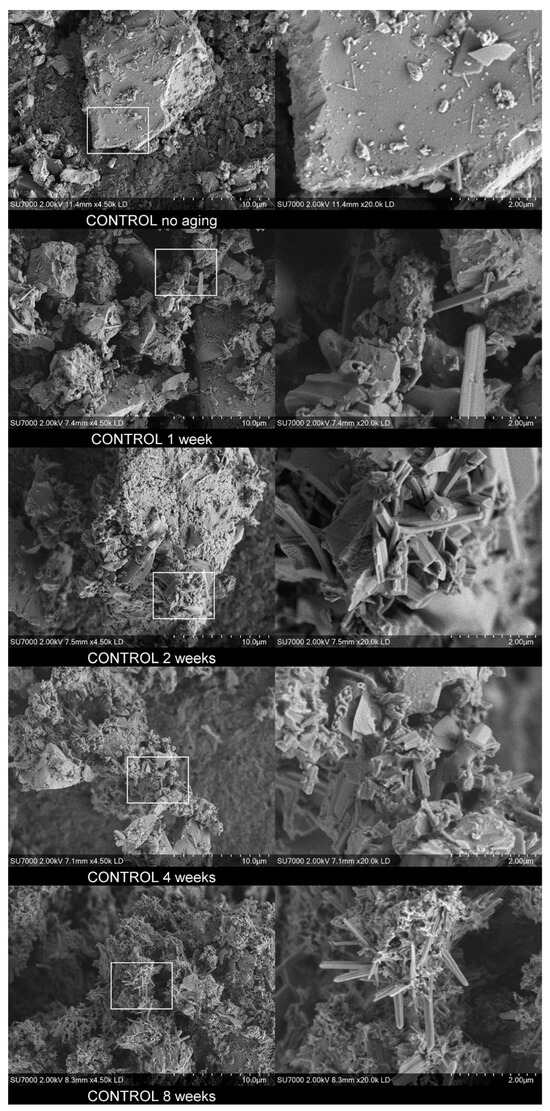
Figure 7.
Evolution of morphology/prehydration with increased aging for the control cement.
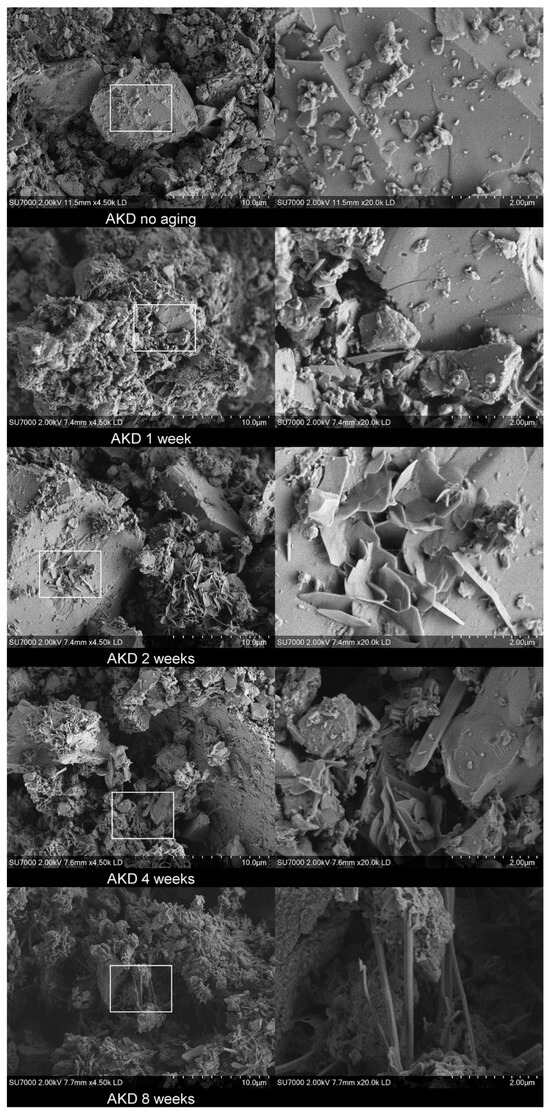
Figure 8.
Evolution of morphology/prehydration with increased aging for the AKD-treated cement.
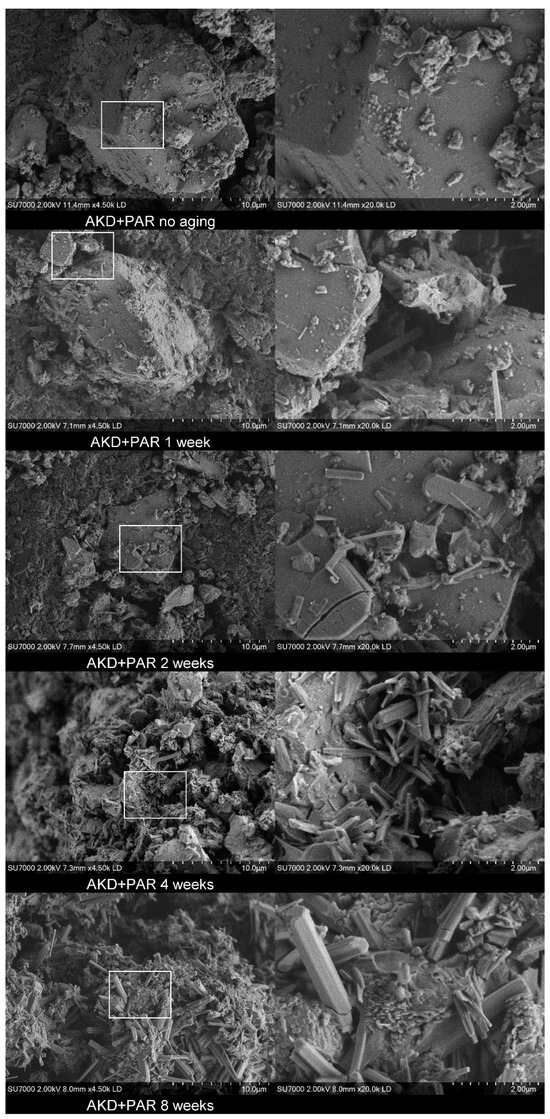
Figure 9.
Evolution of morphology/prehydration with increased aging for the AKD + paraffin-treated cement.
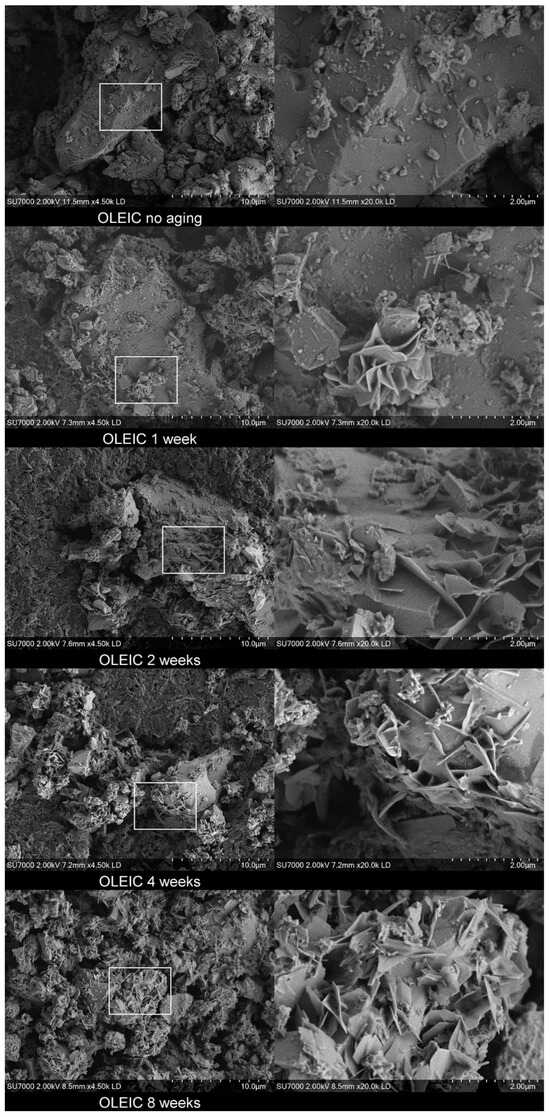
Figure 10.
Evolution of morphology/prehydration with increased aging for the oleic acid-treated cement.
3.3. Paste Calorimetry
The prehydration impacted both the kinetics (Figure 11) and cumulative heat (Figure 12) with diminishing reactivity and heat evolution with increasing duration of accelerated aging.
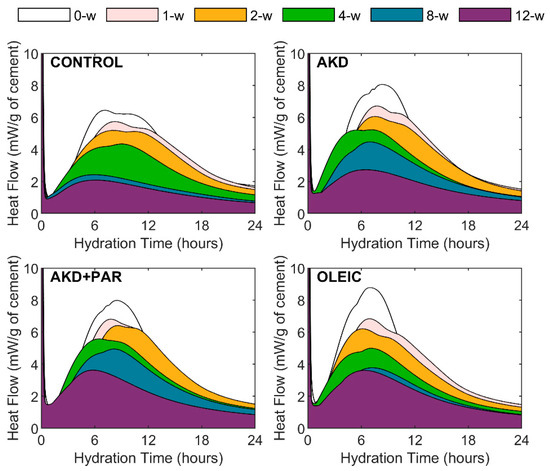
Figure 11.
Changes in heat transfer from pastes with increased cement aging.
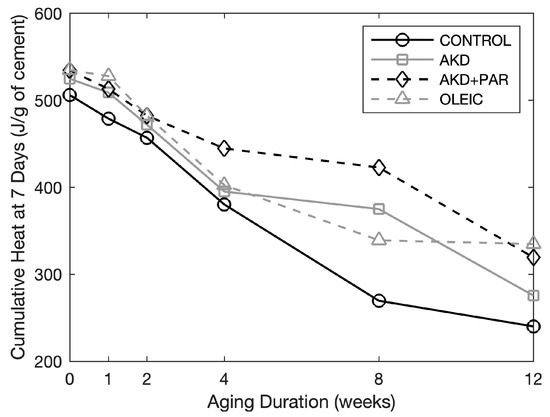
Figure 12.
Changes in cumulative 7-day heat generation with increased cement aging.
3.4. Mortar Fresh Properties
At four weeks of accelerated aging, all the mortars exhibited a drop in flow, but the mortar produced with the AKD + paraffin-treated cement was the least affected (Figure 13). As flow decreased, proper consolidation of specimens became more difficult, especially at 8 weeks for the control and oleic acid-treated cements and at 12 weeks for the AKD and AKD + paraffin-treated cements. As the mortar mixtures became unworkable, and consolidation became more difficult, the air content increased accordingly at 8 and 12 weeks of accelerated aging (Figure 14).

Figure 13.
Fresh mortar flow with increased cement aging.
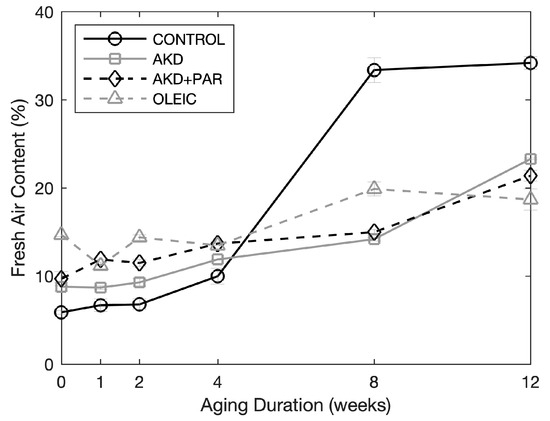
Figure 14.
Air content with increased cement aging.
3.5. Mortar Semi-Adiabatic Calorimetry
As with the paste calorimetry, the peak temperatures decreased as the duration of the accelerated aging regime increased. However, contrary to the paste calorimetry results, where the onset of hydration was accelerated as aging increased, for the mortars, the onset of hydration was retarded (Figure 15).
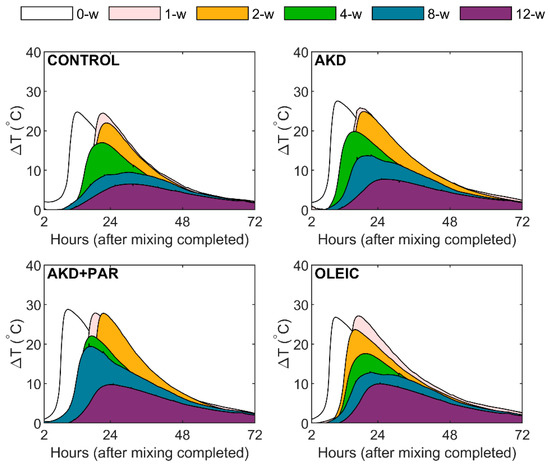
Figure 15.
Difference in mortar temperature versus room temperature data over time with increased cement aging.
3.6. Compressive Strength
For all the mortars, the compressive strength decreases as the duration of accelerated aging increased (Figure 16, Figure 17 and Figure 18), but more informative trends can be observed when strength is expressed as a ratio between the mortars made with the treated cement and the mortars made with the control cement (Figure 19). The mortars made with the treated cements perform far better between 8 and 12 weeks of aging when compared to the control. But the strengths are more similar for the interval between 0 and 4 weeks of aging (Figure 20). For the AKD mortar made with unaged cement (prior to the accelerated aging regime), the strengths exceeded those of the control after 7 and 28 days of curing, but after 90 days of curing, the strengths were equivalent. For both the AKD mortar and the AKD + paraffin mortar made with cement that experienced 1 and 4 weeks of accelerated aging, the strengths exceeded the control.
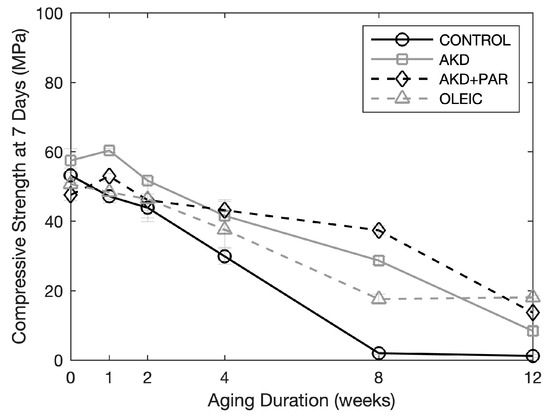
Figure 16.
Change in 7-day compressive strength with increased cement aging.
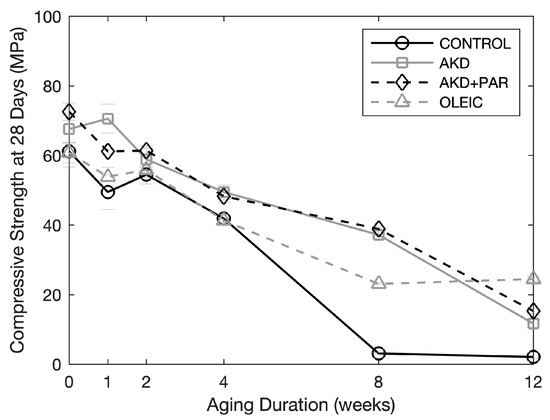
Figure 17.
Change in 28-day compressive strength with increased cement aging.
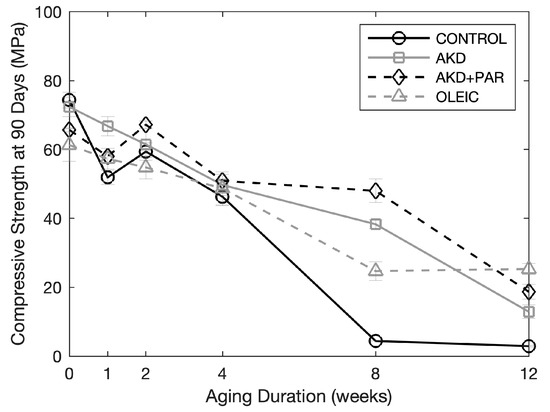
Figure 18.
Change in 90-day compressive strength with increased cement aging.
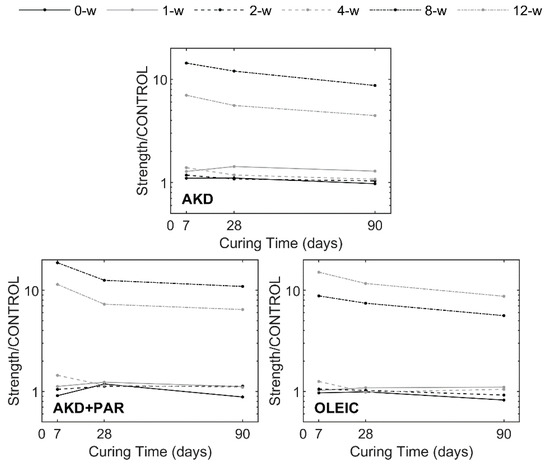
Figure 19.
Ratio of compressive strength relative to the CONTROL with increased cement aging for all durations.
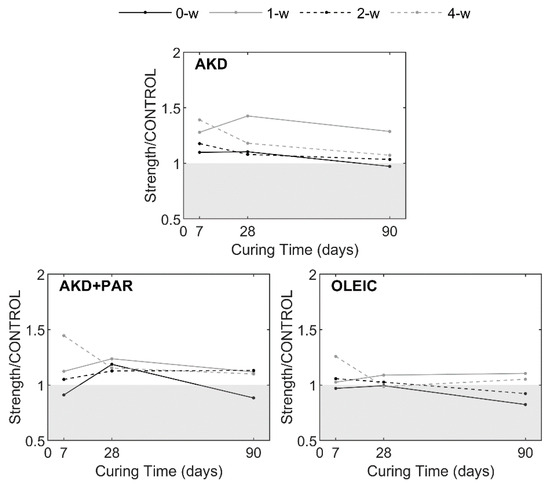
Figure 20.
Ratio of compressive strength relative to the CONTROL with increased cement aging for durations up to 4 weeks.
3.7. Clinker Milling
The particle size distributions after milling were similar (Figure 21) but with subtle differences. The control exhibited a slightly coarser particle size distribution (Table 3). Generally, a coarser particle size corresponds to lower values for a specific surface, but this was not the case for the control (Table 4). The milled AKD + paraffin-treated clinker and the oleic acid-treated clinker both exhibited surface areas slightly lower than the control. This unexpected result could be due to the agglomerations previously observed in the treated cements (Figure 1). However, this hypothesis was not tested as sonication (and the resultant disruption of agglomerations) was consistently employed for all particle size distribution trials.
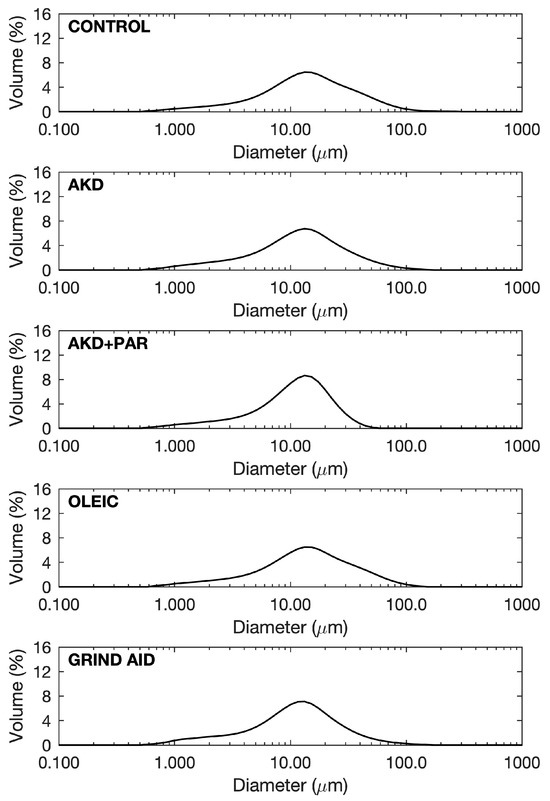
Figure 21.
Particle size distributions of milled clinkers (with sonication) after milling.

Table 3.
Milled clinker particle diameters at the 10th, 50th, and 90th percentiles.

Table 4.
Blaine air permeability surface area.
4. Discussion
4.1. Particle Agglomeration
Even prior to prehydration, the hydrophobic additives lead to the agglomeration of cement particles (Figure 1), with modal peaks around 10 μm and secondary peaks in the 200 μm size range. Sonication disrupts the secondary peaks, decreasing the modal peak values to 4 to 6 μm. In the SEM images prior to any prehydration, when compared with the control (Figure 7), the as-produced treated cements show a higher degree of agglomeration (Figure 8, Figure 9 and Figure 10). As aging increases, particle sizes also increase for all the cements (Figure 6) even though sonication was consistently employed. After 12 weeks of accelerated aging, the control cement shows by far the largest particle sizes (Table 2, Figure 22).
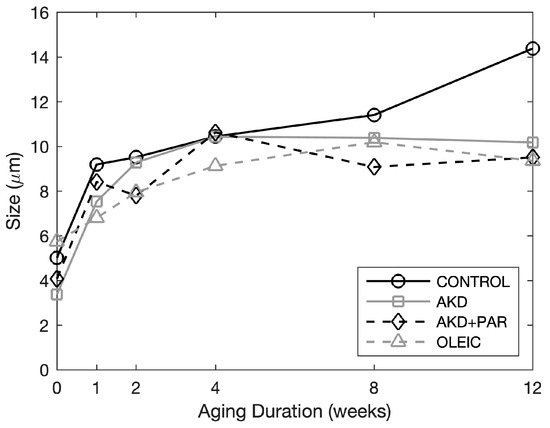
Figure 22.
Increase in median particle size with increased cement aging.
The observed coarsening of particle sizes as accelerated aging progresses is due to the binding of neighboring cement particles with hydration phases. At one week of aging, the control cement exhibits slender rods, likely Ca6Al2(SO4)3(OH)12·26H2O (ettringite), on the order of 10 μm in length bridging adjacent particles (Figure 7). Even prior to the accelerated aging regime, similar rods appear, but much smaller in size, on the surface of the large cement grain (Figure 7). After continued aging, occurrences of ettringite intensify, together with bladed laths, possibly mixed Ca(OH)2 (portlandite), and calcium silicate hydrates (C-S-H). The same pattern occurs for the treated cements (Figure 8, Figure 9 and Figure 10), but at 1 week of accelerated aging, the treated cement particles exhibit fewer instances of hydration products as compared with the control (Figure 7) and are without evidence of prehydration prior to the start of the accelerated aging regime. After 2 weeks, for the treated cements, hydration products are present, but still to a lesser degree when compared with the control. At 2 weeks, the AKD + paraffin-treated cement appears the least affected by prehydration (Figure 9). At 4 and 8 weeks, all the treated cements exhibit abundant hydration products.
Early research by Abrams [1] into the effects of prehydration recommended the pulverization of lumps/agglomerations as an effective strategy to help mitigate the effects of aging. Looking at the SEM images of the prehydrated cements, such an approach appears viable as the disruption of agglomerations would possibly strip away hydration products and expose the underlying unhydrated regions of cement particles. In addition, pulverization of aged cement may destroy air pockets between adjacent agglomerated particles and thereby help to mitigate excessive air contents in the final hardened product.
4.2. Paste Calorimetry
In all cases, the main hydration peak decreases as aging increases (Figure 11). The largest decrease occurs in the paste made with the control cement, which also exhibited consistently lower cumulative heats of hydration when compared with the treated cements (Figure 12). This is true even for the unaged condition, where all the pastes from the treated cements exhibit slightly higher cumulative heat values. This improvement in hydration may be attributed to slightly finer particle size distributions for the treated cements. Looking at the particle size distributions for the unaged cements (Figure 6, Table 2), the AKD and AKD + paraffin-treated cements are all slightly finer than the control, and although the oleic acid treated cement is slightly coarser overall, it also exhibits the largest fraction of sub-micron particles. Although the surface area was not directly measured for the treated cements, the size distributions suggest it may have played a role in their improved hydration relative to the control. At the earlier durations of accelerated aging, from 1 to 2 weeks, the pastes made with the treated cements all perform similarly, but from 4 to 8 weeks, the AKD + paraffin-treated cement maintains the highest cumulative heat values. After 12 weeks for treated cements, and after just 8 weeks for the control, all show a severe drop in the cumulative heat generated.
When compared with the paste made with the unaged cements, the induction period is shortened for all pastes made with the aged cements (Figure 23). Hartman and Plank [41] attribute this earlier onset of acceleration to coatings of ettringite, acting as seeds for further hydration reactions. They also attribute these coatings to the lower values observed for the initial silicate hydration peak, as the coatings may limit the access of water to silicate phases [41]. Many researchers have found that prehydration not only decreases the magnitude of the main hydration peak but also delays it [10,12,23,37,41,42]. This was not consistently the case here for the treated cements, where the main hydration peak occurred earlier in some instances, especially after extended aging of 4 weeks and beyond (Figure 11). A similar phenomenon was observed by Khigerovich [29] and Dvorkin and Dvorkin [32], who speculated that as prehydration advances, oleic acid may migrate towards the interiors of cement grains, prying open microcracks, exposing more surface area, and improving hydration. Similar wedging could also explain the earlier main hydration peak seen here for pastes made with the AKD and AKD + paraffin cements, but this hypothesis was not explored further.

Figure 23.
Heat transfer for pastes made with unaged and aged cements.
4.3. Mortar Fresh Properties
Unlike the pastes, the mortars made with the aged cements experienced a delay in the onset of the acceleration period and a delay in the achievement of the main hydration peak (Figure 24). One contributing factor could be the mortars’ considerably lower w/c of 0.38, as compared with that of the paste with a w/c of 0.5. The higher w/c of the paste would allow for better access to water. Another contributing factor could be the presence of the superplasticizer; Winnefeld [37] reported delays in the onset of the acceleration period for prehydrated cements in the presence of superplasticizers. As with the pastes, the extent of hydration decreases as aging increases, as indicated by the reduction in the maximum temperature achieved (Figure 25). Finally, for the AKD and AKD + paraffin-treated cements, although the hydration peak is delayed for the aged cements (Figure 24), at 4 weeks, it is delayed to a lesser degree than at 1 and 2 weeks, possibly reinforcing the “wax wedging” hypothesis [29,32].

Figure 24.
Time to peak temperature in the semi-adiabatic chamber with increasing duration of aging.
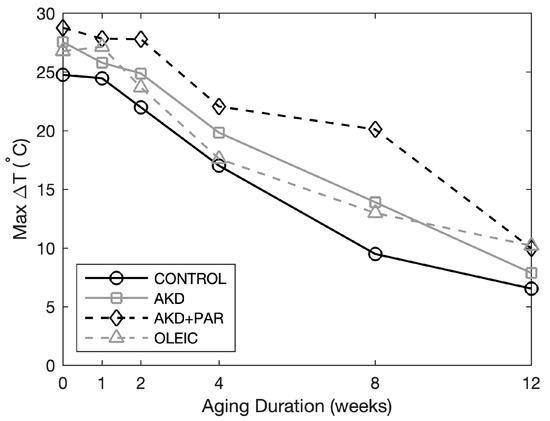
Figure 25.
Peak temperature, expressed as the difference between mortar and room temperature, with increasing duration of aging.
Flow was not dramatically affected up to two weeks of aging (Figure 13), but after four weeks, flow decreased significantly, although this was slightly less pronounced for the mortar produced with AKD + paraffin. At 8 weeks, there was a drastic drop in workability for all the mortars, but to a slightly lesser degree for mortars made with the AKD + paraffin and AKD-treated cements. The decrease in flow aligns with an increase in entrapped air (Figure 14). The tendency for fatty acid-based treatments to encourage air entrainment is well documented [34,35] and was confirmed here, with the mortar made with the oleic acid-treated cement showing the highest air content for unaged cement, followed by the mortars made with the AKD and AKD + paraffin-treated cements.
4.4. Effect of Prehydration on Hardened Mortar Properties
Across the board, as cement aging increases, mortar strength decreases. But the strength decrease is more dramatic for the mortars made with the control cement (Figure 16, Figure 17 and Figure 18). The drop in strength is most pronounced after 8 and 12 weeks of aging (Figure 19). Between 1 and 4 weeks of aging, the strengths of the mortars made with the treated cements are higher than the control, with the exception of the 90-day strengths (Figure 20). Abrams [1] reported that the negative effect of aging on strength decreases as curing times increase. Prior to the accelerated aging regime, the mortars made with both the oleic acid and AKD + paraffin-treated cements had lower 7 d strengths than the mortars made with the control cement (89% of the control for AKD + paraffin and 95% for oleic acid). The strength loss is due to higher air contents; 9.7 vol.%, and 14.7 vol.% for AKD + paraffin and oleic acid, respectively, as compared to the control at 5.9 vol.%. This loss in strength is not unexpected given the inverse relationship between strength and porosity (Figure 26) [55]. While the observed reduction in workability leads to poor consolidation and increased entrapped air, another contributing factor could be the tendency towards agglomeration and “lumps” as prehydration increases. Such lumps occur as cement particles become bound by prehydration products, entrapping air between neighboring grains—this entrapped air is not fully released during mixing [46].
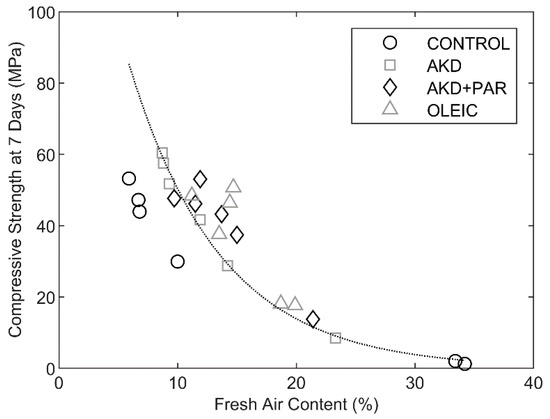
Figure 26.
Fresh air content versus 7-day compressive strength.
In our previous study [46], we observed enhanced strength for concrete made with AKD and AKD + paraffin-treated cements when compared with concrete made with control cement, regardless of whether the cements had experienced prehydration or not. This was not the case for the mortars studied here. After exposure to the aging regime, the mortars made with the treated cements consistently outperformed the mortars made with the control. But prior to the aging regime, the mortars made with the AKD + paraffin and oleic acid-treated cements were slightly weaker than the mortars made with the control. Aside from the tendency for higher air contents, another contributing factor could be the presence of agglomerated particles in the treated cements (Figure 1). In the previous concrete experiments, mixing conditions were more aggressive with rough calcined bauxite aggregate, disrupting agglomerations and leading to improved hydration. During mortar mixing with smooth quartz sand, there was less effective dispersal of agglomerations.
Based on observed strength losses reported by other researchers, a rough estimate was made for the equivalent real-life storage times at ambient temperature and humidity to the time period of accelerated aging for this experiment (Figure 27). Here, 1 to 2 weeks of accelerated aging was judged to be equivalent to 1 to 2 months of storage, 4 weeks of accelerated aging equivalent to 3 to 6 months of storage, and 8 weeks of accelerated aging equivalent to 5 to 10 years of storage.
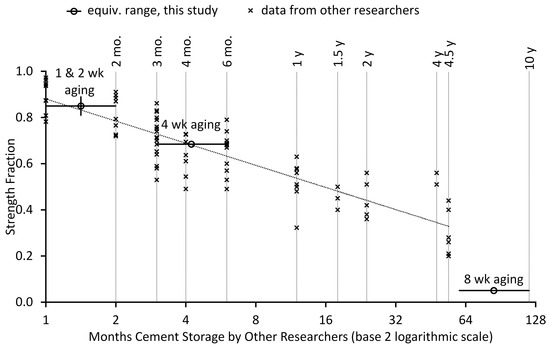
Figure 27.
Decrease in strength for 28 d cured concretes and mortars made with cement aged under ambient conditions [1,4,5,6,8] compared to the control mortars from this study made with cements exposed to the accelerated aging regime.
5. Conclusions
The AKD wax and AKD + paraffin hydrophobic additives both proved to be effective treatments for delaying prehydration under warm and humid storage conditions. In the short term, after 1 week of accelerated aging (equivalent of up to 2 months of storage), the mortar made with the AKD-treated cement showed a 7 d strength increase of 13% relative to the baseline control mortar made with the untreated and unaged cements. After longer periods of accelerated aging, the mortars made with the AKD + paraffin-treated cement performed the best. At 4 weeks of accelerated aging (equivalent of up to 6 months of storage), the mortars made with AKD + paraffin experienced a loss in 7 d strength of just 19% relative to the control baseline of mortar made with untreated cement, which experienced a strength loss of 44%. At 8 weeks of accelerated aging (equivalent to 5 to 10 years of storage), the mortars made with the AKD + paraffin cement experienced a loss in 7 d strength of 30% compared to the mortar made with untreated cement, which experienced a strength loss of 96%. After 12 weeks of accelerated aging, where no equivalent duration of storage could be estimated based on the literature, the hydrophobic additives were not as effective, and the mortars made with the AKD and AKD + paraffin-treated cements experienced 7-day strength losses of 84 and 74%, respectively.
The feasibility of using AKD and AKD + paraffin as a grinding aid was demonstrated, with both treatments yielding milled clinker size distributions that were equivalent to those produced using the commercial grinding aid. For a typical grinding aid, dosages are in the range of 0.25 to 0.5 kg per tonne of cement, at a cost of USD 1 to USD 1.75 per kg (personal communication, C. Buchanan III, 21 September 2022). The dosages explored in this research would require about 1.5 kg of AKD and 3 kg of paraffin per tonne of cement, at a cost of USD 3 per kg for AKD [56] and USD 1.50 per kg for paraffin [57]. Based on these cost estimates and dosages, and assuming complete replacement of the grinding aid, the AKD pretreatment would cost 2 to 6 times as much as the grinding aid and AKD + paraffin would cost 7 to 24 times as much as the grinding aid. Despite the cost increase, such a solution could be of interest to cement markets in regions with high temperatures and humidity, such as Indonesia and India.
Author Contributions
Conceptualization, A.O. and A.K.; methodology, A.O. and A.K.; validation, P.Z., L.H.B. and O.C.; formal analysis, A.O., A.K., P.Z. and K.P.; investigation, A.O., A.K., P.Z., L.H.B., O.C. and K.P.; resources, A.O. and A.K., data curation, K.P.; writing—original draft preparation, A.O. and P.Z.; writing—review and editing, K.P.; visualization, P.Z. and K.P., supervision, A.O., A.K. and K.P.; project administration, A.O., A.K. and K.P., funding acquisition, A.O. and A.K. All authors have read and agreed to the published version of the manuscript.
Funding
This work was funded by the National Research Council Canada [NRC-IRAP Project #970310].
Data Availability Statement
The original contributions presented in this study are included in this article. Further inquiries can be directed to the corresponding author.
Acknowledgments
Particle size analyses were performed at the Walter Curlook Materials Characterization & Processing Laboratory, scanning electron microscopy was performed at the Open Centre for the Characterization of Advanced Materials (OCCAM), and thank you to Stephen Parkes for coordination of the donation of clinker samples.
Conflicts of Interest
The authors declare no conflicts of interest. The funders had no role in the design of this study; in the collection, analyses, or interpretation of data; in the writing of this manuscript; or in the decision to publish the results.
References
- Abrams, D.A. Effect of Storage of Cement, Bulletin 6; Structural Materials Research Laboratory, Lewis Institute: Chicago, IL, USA, 1920; 28p. [Google Scholar]
- Sprung, S. Effect of storage conditions on the properties of cement. Zem-Kalk-Gips 1978, 6, 305–309. [Google Scholar]
- Berdov, G.; Ilyiina, L. Activatziya tzementov deistviem dobavok electrolitov (Cement activation by electrolyte additives), Mezhdunarodniy Zhurnal Prikladnikh i Fundamentalnikh Issledovaniy. Int. J. Appl. Basic Res. 2010, 9, 55–57. [Google Scholar]
- Ilyiina, L. Povisheniye Eksplutatzionnikh Kharakteristik Stroitelnikh Materialov na Osnove Tzementa Dlitelnogo Khraneniya (Improvement of Performance of Building Materials Based on Cement after Its Long-Term Storage). Doctoral Dissertation, Siberian State University of Architecture and Civil Engineering, Novosibirsk, Russia, 2011. [Google Scholar]
- Lovely, K.M.; Chacko, A. A study on strength characteristics of ordinary portland cement due to storage. Int. J. Innov. Res. Sci. Eng. Technol. 2013, 2, 612–616. [Google Scholar]
- Getachew, B.; Adugna, T.; Assefa, S. Investigation on the effect of storage time due to moisture absorption of cement on the properties of concrete. Int. J. Dev. Res. 2018, 8, 18558–18561. [Google Scholar]
- Ma’aruf, A.; Nuruddeen, M.M.; Mukhtar, H.K. Effects of cement prehydration on concrete properties. Int. J. Eng. Sci. Res. IJESR/ICRIT-IV Spec. Issue 2018, 4, 15–20. [Google Scholar]
- Ibrahim, A.J. The effect of storage period on the physical and mechanical properties of cement. Civ. Environ. Res. 2018, 10, 71–84. [Google Scholar]
- Silva, D.A.; Thomas, J.; Kazmierczak, D.; Cheung, J. Pre-hydration of cement: Global survey and laboratory results. ZKG Int. 2018, 6, 55–60. [Google Scholar]
- Schmidt, G.; Bier, T.A.; Wutz, K.; Maier, M. Characterization of the ageing behavior of premixed dry mortars and its effect on their workability properties. ZKG Int. 2007, 60, 94–103. [Google Scholar]
- Ramge, P.; Schmidt, W.; Kühne, H.-C. Effect of the storage of cement on early properties of cementitious systems. In Proceedings of the International Conference on Advances in Cement and Concrete Technology in Africa, Johannesburg, South Africa, 28–31 January 2013; pp. 339–347. [Google Scholar]
- Whittaker, M.; Dubina, E.; Al-Mutawa, F.; Arkless, L.; Plank, J.; Black, L. The effect of prehydration on the engineering properties of CEM I Portland cement. Adv. Cem. Res. 2013, 25, 12–20. [Google Scholar] [CrossRef]
- Adamtsevich, A.; Eremin, A.; Pustovgar, A.; Pashkevich, S.; Nefedov, S. Research on the effect of prehydration of portland cement stored in normal conditions. Appl. Mech. Mater. 2014, 670–671, 376–381. [Google Scholar] [CrossRef]
- Theisen, K.; Johansen, V. Prehydration and strength development of Portland cement. Am. Ceram. Soc. Bull. 1975, 54, 787–791. [Google Scholar]
- Goswami, G.; Mohapatra, B.; Panda, J.D. Gypsum dehydration during comminution and its effect on cement properties. J. Am. Ceram. Soc. 1990, 73, 721–723. [Google Scholar] [CrossRef]
- Den, C.-S.; Breen, C.; Yarwood, J.; Habesch, S.; Phipps, J.; Craster, B.; Maitland, G. Aging of oilfield cement at high humidity: A combined FEG-ESEM and Raman microscope investigation. J. Mater. Chem. 2002, 12, 3105–3112. [Google Scholar] [CrossRef]
- Hartmann, F.A.; Mengel, L.C.; Plank, J.P. Effects of exposure to atmospheric moisture and CO2 on the performance of a ternary binder system and chemical admixtures in a self-levelling underlayment. Constr. Build. Mater. 2022, 350, 128911. [Google Scholar] [CrossRef]
- Jensen, O.M.; Hansen, P.F.; Lachowski, E.E.; Glasser, F.P. Clinker mineral hydration at reduced relative humidities. Cem. Concr. Res. 1999, 29, 1505–1512. [Google Scholar] [CrossRef]
- Dubina, E.; Wadsö, L.; Plank, J. A sorption balance study of water vapour sorption on anhydrous cement minerals and cement constituents. Cem. Concr. Res. 2011, 41, 1196–1204. [Google Scholar] [CrossRef]
- Dubina, E.; Black, L.; Sieber, R.; Plank, J. Interaction of water vapour with anhydrous cement minerals. Adv. Appl. Ceram. 2013, 109, 260–268. [Google Scholar] [CrossRef]
- Dubina, E.; Plank, J.; Black, L.; Wadsö, L. Impact of environmental moisture on C3A polymorphs in the absence and presence of CaSO4 · 0·5 H2O. Adv. Cem. Res. 2014, 26, 29–40. [Google Scholar] [CrossRef]
- Ylmén, R.; Jäglid, U. Carbonation of portland cement studied by diffuse reflection Fourier transform infrared spectroscopy. Int. J. Concr. Struct. Mater. 2013, 7, 119–125. [Google Scholar] [CrossRef]
- Stoian, J.; Oey, T.; Bullard, J.W.; Huang, J.; Kumar, A.; Balonis, M.; Terrill, J.E.; Neithalath, N.; Sant, G. New insights into the prehydration of cement and its mitigation. Cem. Concr. Res. 2015, 70, 94–103. [Google Scholar] [CrossRef]
- Dubina, E.; Plank, J.; Black, L. Impact of water vapour and carbon dioxide on surface composition of C3A polymorphs studied by X-ray photoelectron spectroscopy. Cem. Concr. Res. 2015, 73, 36–41. [Google Scholar] [CrossRef]
- Maciel, M.H.; Romano, R.C.O.; Pileggi, R.G. Hy_Surf model: Viscoelastic evolution in Portland cement suspensions during the early-age hardening. Cem. Concr. Res. 2023, 174, 107342. [Google Scholar] [CrossRef]
- Korovkin, M.; Eroshkina, N. Influence of superplasticizer on cement grinding and its activity reduction during storage. Procedia Eng. 2016, 150, 1600–1604. [Google Scholar] [CrossRef]
- Pique, T.M.; Baueregger, S.; Plank, J. Influence of temperature and moisture on the shelf-life of cement admixed with redispersible polymer powder. Constr. Build. Mater. 2016, 115, 336–344. [Google Scholar] [CrossRef]
- Khigerovich, M. Method of Producing Hydrophobic Cements. Russian Patent RU 84554, 31 December 1950. [Google Scholar]
- Khigerovich, M. Gidrofobnyi Tsement i Gidrofobno-Plastifitsiruyushchie Dobavki (Hydrophobic Cement and Hydrophobically Plasticizing Additives); Gosudarstvennoe Izdatel’stvo Literatury po Stroitel’nym Materialam: Moscow, Russia, 1957; 208p. [Google Scholar]
- Stoll, U.W. Hydrophobic cement. In ASTM STP205: Cement and Concrete; American Society for Testing Materials: Philadelphia, PA, USA, 1958; pp. 7–15. [Google Scholar]
- Khigerovich, M.; Baier, V. Gidrofobno-Plastifitsiruyushchie Dobavki Dlya Tsementov, Rastvorov i Betonov (Hydrophobically-Plasticizing Additives for Cements, Mortars and Concretes); Stroyizdat: Moscow, Russia, 1979; 125p. [Google Scholar]
- Dvorkin, L.; Dvorkin, O. Stroitelniye Mineralnie Vyachshuschiye Materiali (Mineral Construction Binding Materials); Infra-Ingeneriya: Moscow, Russia, 2011; 541p. [Google Scholar]
- Vektaris, B.; Kaziliūnas, A.A.; Striūgienė, I. Aging of dry cement mixes for finishing purposes. Mater. Sci. 2013, 3, 326–330. [Google Scholar] [CrossRef][Green Version]
- Griffin, D.F.; Lorman, W.R. Interim Report on Hydrophobic Cement; U. S. Project NY 430 030-8.02, Technical Note N-303; Naval Civil Engineering Research and Evaluation Laboratory: Port Hueneme, CA, USA, 1957; 14p. [Google Scholar]
- Albayrak, A.T.; Muzaffer, Y.; Gurkaynak, M.A.; Gurkey, I. Investigation of the effects of fatty acids on the compressive strength of the concrete and the grindability of the cement. Cem. Concr. Res. 2005, 35, 400–404. [Google Scholar] [CrossRef]
- Maltese, C.; Pistolesi, A.; Bravo, A.; Cella, F.; Cerulli, T.; Salvioni, D. A case history: Effect of moisture on the setting behaviour of a Portland cement reacting with an alkali-free accelerator. Cem. Concr. Res. 2007, 37, 856–865. [Google Scholar] [CrossRef]
- Winnefeld, F. Influence of cement aging and addition time on the performance of superplasticizers. ZKG Int. 2008, 61, 68–77. [Google Scholar]
- Dubina, E.; Plank, J. Influence of moisture- and CO2-induced aging in cement on the performance of admixtures used in construction chemistry. ZKG Int. 2012, 65, 60–68. [Google Scholar]
- Sun, Z.; Shui, L.; Yang, H.; Liu, Y.; Ji, Y. Effect of prehydration on properties of cement and interaction between prehydrated cement and polycarboxylate superplasticizer. J. Chin. Ceram. Soc. 2016, 44, 647–650. [Google Scholar] [CrossRef]
- Meier, M.R.; Napharatsamee, T.; Plank, J. Dispersing performance of superplasticizers admixed to aged cement. Constr. Build. Mater. 2017, 139, 232–240. [Google Scholar] [CrossRef]
- Hartmann, F.A.; Plank, J. New insights into the effects of aging on Portland cement hydration and on retarder performance. Constr. Build. Mater. 2021, 274, 122104. [Google Scholar] [CrossRef]
- Ferraz, D.F.; Martho, A.C.R.; Burns, E.G.; Romano, R.C.O.; Pileggi, R.G. Effect of prehydration of Portland cement on the superplasticizer consumption and the impact on the rheological properties and chemical reaction. Rev. Ibracon Estrut. Mater. 2023, 16, e16210. [Google Scholar] [CrossRef]
- Sivakumar, R.; Halee, B.; Suraneni, P. Effect of calcium sulfoaluminate cement prehydration on hydration and strength gain of calcium sulfoaluminate cement-ordinary portland cement mixtures. Cem. Concr. Comp. 2020, 112, 103694. [Google Scholar] [CrossRef]
- Kerienė, J.; Antonovič, V.; Stonys, R.; Boris, R. The influence of the aging of calcium aluminate cement on the properties of mortar. Constr. Build. Mater. 2019, 205, 387–397. [Google Scholar] [CrossRef]
- Lv, L.; Šavija, B.; Li, L.; Cui, H.; Han, N.; Xing, F. Prehydration of calcium sulfoaluminate (CSA) clinker at different relative humidities. Cem. Concr. Res. 2021, 144, 106423. [Google Scholar] [CrossRef]
- Ozersky, A.; Khomyakov, A.; Peterson, K. Extended shelf life cement: Principles, microstructural analysis, and physical-mechanical properties of the cement and concrete. Constr. Build. Mater. 2021, 266 Pt B, 121202. [Google Scholar] [CrossRef]
- Ozersky, A.; Khomyakov, A. Cement and Process for Producing Self-Protecting Cement. World Patent WO 2020/073119 A1, 16 April 2020. [Google Scholar]
- Ozersky, A.; Khomyakov, A.; Zhao, P.; Herzog Bromerchenkel, L.; Chernoloz, O.; Peterson, K. Increasing the Shelf Life of Portland Cement. In Smart & Sustainable Infrastructure: Building a Greener Tomorrow; Banthia, N., Soleimani-Dashtaki, S., Mindess, S., Eds.; RILEM Bookseries; Springer: Cham, Switzerland, 2023; Volume 48. [Google Scholar] [CrossRef]
- CAN/CSA-A3000-18; Cementitious Materials Compendium. CSA Group: Toronto, ON, Canada, 2018; 246p.
- ASTM C778-21; Standard Specification for Standard Sand. American Society for Testing and Materials: West Conshohocken, PA, USA, 2021; 3p.
- ASTM C1437-20; Standard Test Method for Flow of Hydraulic Cement Mortar. American Society for Testing and Materials: West Conshohocken, PA, USA, 2020; 2p.
- ASTM C185-20; Standard Test Method for Air Content of Hydraulic Cement Mortar. American Society for Testing and Materials: West Conshohocken, PA, USA, 2020; 4p.
- ASTM C109/C109M-21; Standard Test Method for Compressive Strength of Hydraulic Cement Mortars (Using 2-in. or [50 mm] Cube Specimens). American Society for Testing and Materials: West Conshohocken, PA, USA, 2021; 12p.
- ASTM C204-18e1; Standard Test Methods for Fineness of Hydraulic Cement by Air-Permeability Apparatus. American Society for Testing and Materials: West Conshohocken, PA, USA, 2020; 11p.
- Mehta, P.K.; Monteiro, P.J.M. Concrete: Microstructure, Properties, and Materials, 3rd ed.; McGraw-Hill: New York, NY, USA, 2006; p. 649. [Google Scholar]
- PaperIndex|Contact Paper Industry Suppliers, Exporters, Manufacturers, and Wholesalers Online|B2B Marketplace of the Global Pulp & Paper Industry|USA, Canada, China, India, Indonesia|South/North America, Europe, Asia. 2024. PaperIndex. Available online: https://www.paperindex.com/ (accessed on 23 April 2024).
- Paraffin Wax Prices|Current and Forecast|Intratec.us. 2024. Intratec. Available online: https://www.intratec.us/chemical-markets/paraffin-wax-price (accessed on 23 April 2024).
Disclaimer/Publisher’s Note: The statements, opinions and data contained in all publications are solely those of the individual author(s) and contributor(s) and not of MDPI and/or the editor(s). MDPI and/or the editor(s) disclaim responsibility for any injury to people or property resulting from any ideas, methods, instructions or products referred to in the content. |
© 2024 by the authors. Licensee MDPI, Basel, Switzerland. This article is an open access article distributed under the terms and conditions of the Creative Commons Attribution (CC BY) license (https://creativecommons.org/licenses/by/4.0/).